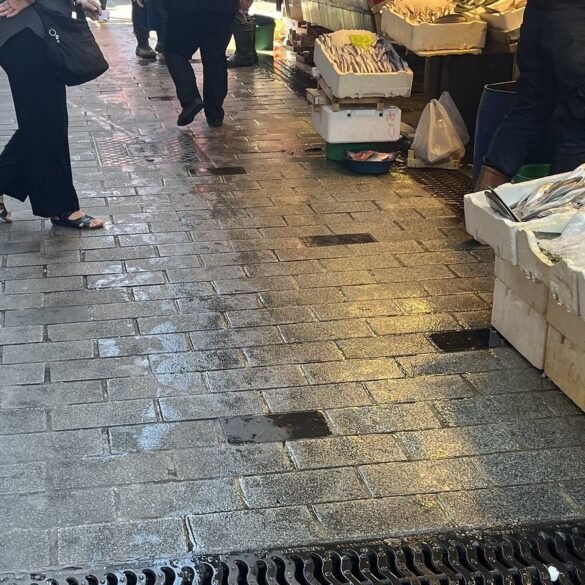This will be a different kind of post. Normally, we describe places we’ve been to, but today we want to tell you about a country we want to visit.
Recently, the area where we live saw a boom of Yemeni coffeehouses popping up here and there. These spacious, lavishly decorated oases of delicious coffee drinks laced with cardamom and ginger are open late and have become our new favorite spots to work on this blog. And as we spend more and more time at these cafés, an unconventional thought started to creep in.
Should we add Yemen to the list of places to visit?
The closest we got to Yemen was in December 2023, when we traveled through neighboring Oman, but hopping over the border was not an option. Yemen is still mired in a years-long civil war, and the U.S. State Department’s travel advisory has been very blunt about it for years—“Do Not Travel”. And just like that, a few weeks after our trip to Oman, the U.S. launched a series of airstrikes in Yemen, targeting Houthis for previously attacking cargo ships in the Red Sea.
For obvious reasons, the country is a no-go zone now. Yet, we hope that maybe one day the situation will change. We want to see Yemenis live in peace and not have to flee their homeland. And once peace arrives, we’ll be on our way to see it.
But what’s in Yemen? Why do we want to go there?
For starters, we look forward to visiting another “coffee” country. And Yemen is the granddaddy of coffee destinations. Although coffee originated in Ethiopia, it was actively cultivated in Yemen long before the rest of the world discovered it. And it was the Yemeni port of Mokha (or Mocha), through which the Ottoman rulers established the coffee trade and from which Dutch traders smuggled precious Arabica seedlings to their colony in Indonesia to establish large-scale coffee plantations. The rest is history: coffee went on to conquer the world, while the Yemeni port city’s legacy was cemented in the name of a popular caffè mocha drink.
We’d love to go to the Haraz region in the western highlands for its terraced mountain farms that produce the highly prized Arabica beans. Another place is the Matari region near the capital, also known for its coffee farms. Not surprisingly, our two favorite Yemeni coffee shops in the Chicagoland area are Haraz Coffee House and Matari Coffee Co.


In addition to staying at coffee farms and sipping coffee in Yemeni coffee shops located in Yemen, the sites that we look forward to seeing the most on the mainland are Shibam and Sana’a. Both are on the UNESCO World Heritage list and present examples of unique desert architecture.
Shibam is a truly surreal place. The first time I saw the pictures, I thought it was something out of a sci-fi movie. While in Oman, we visited mudbrick towns, but the buildings were just a few stories tall. Shibam is mudbrick architecture on steroids. Dubbed as “Manhattan of the Desert,” this is where you find mudbrick skyscrapers (!). Some buildings reach 11 stories tall. Not Burj Khalifa exactly, but something that we haven’t seen anywhere in the world.
The buildings in the Old City of Sana’a are not as tall, but they are as extraordinary as Shibam’s. These whimsical, gingerbread houses look like something out of the pages of One Thousand and One Nights or if they were created by a Middle Eastern Antonio Gaudí. Once the conflict is over, the capital city of Sana’a should be a “must” stop on travelers’ itineraries just for these beautifully ornate buildings alone.
Now we get to the most intriguing part. Technically, it’s possible to visit Yemen even now. Although war-torn mainland Yemen has been a no-go zone for tourists, some intrepid travelers have been visiting Socotra Island. Located in the Arabian Sea, the island is controlled neither by the Houthis (backed by Iran) nor the Yemeni government (backed by Saudi Arabia). At the moment, it is controlled by the Southern Transitional Council (STC), backed by the UAE. And given the UAE’s affinity for developing tourism, the Socotra archipelago has started to see a trickle of visitors. Although it’s complicated and expensive to arrange travel to Socotra, it’s something that can be done. And honestly, it is very tempting to start thinking about visiting Socotra. Called the “Galápagos of the Indian Ocean,” the island has a unique biodiversity with hundreds of rare species and rugged terrain. The most recognized feature—and a national tree of Yemen—is the dragon blood tree that produces red sap. Resembling oversized umbrellas or giant mushrooms, these trees look like something from an alien planet.



Having been to Oman, we expect that our future travel to Yemen would include something already familiar, like strolling through colorful markets permeated with the smell of frankincense or a trip to the desert. But as with every place, something unique is also in store for anyone who visits. Hiking the coffee regions, marveling at creative desert architecture, and traversing Socotra Island in search of the rich biodiversity is something we can’t wait to do. For now, of course, we are limited to researching the history of the country, reading up on the news from the region, and looking at the pictures of the attractions online, all while sipping ginger-infused coffee drinks from the comfort of a Yemeni coffeehouse in our own neighborhood. Once again, the hope is that peace arrives soon and a visit to Yemen becomes a possibility and not something out of a fantasy movie.

